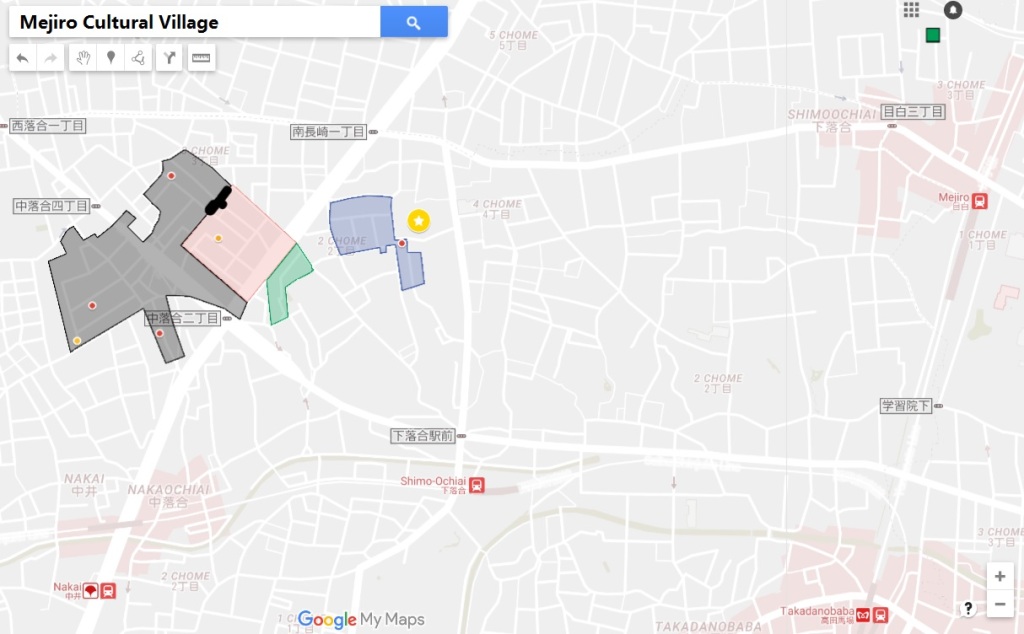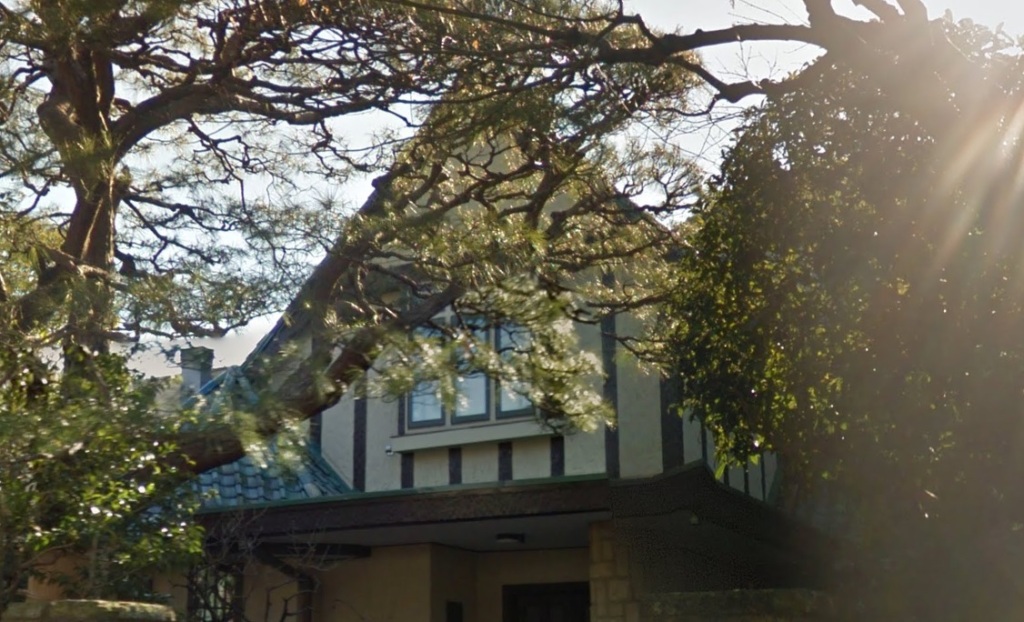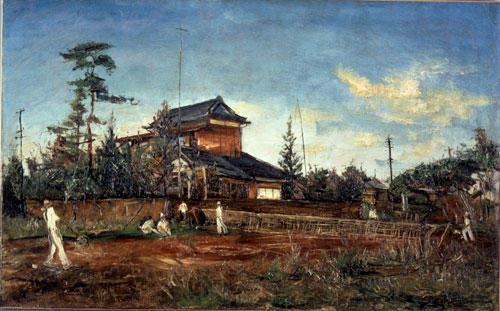Mejiro Cultural Village 目白文化村 めじろぶんかむら (Mejiro Bunkamura) was a luxury residential area 高級住宅街 said to be modeled after Beverly Hills (Note 1). I will provide the general information, but if you’re interested in more details, let me refer you to the following comprehensive website: 落合道人 「気になる目白文化村」オルタネイト・テイク Ochiai Michihi “Interesting Mejiro Culture Village”: an alternate take
- Note 1: Broken link: trust5 co jp/property/mejiro-dori/index.php/land; also: source 2
Where: Mejiro Cultural Village is located in the Ochiai 落合 district of Shinjuku ward, west of Mejiro Station (JR Yamanote line), and north of Nakai and Shimo-Ochiai stations (Seibu-Shinjuku Line).
When: The village was built in the 1920s; many of the houses were destroyed during World War II. Constructions occurred in five stages:
- 1922: 第一文化村 1st cultural village / 目白不動園 Mejiro Fudo Garden
- 1923: 第二文化村 2nd cultural village
- 1924: 第三文化村 3rd cultural village
- 1925: 第四文化村 4th cultural village
- 1929: 第五文化村 5th cultural village
Maps: This is an outline of the Meiji Cultural Village; the colors correspond to the colored sections on the map from following site: 目白文化村.

(See also the “Tokyo urban design” map at bottom.)
What the village looked like (old photos, etc.):
- Mejiro Cultural Village houses: 再現・目白文化村を散歩する吉屋信子。 [気になる下落合]
- Postcards of the village: 目白文化村絵はがき2枚を比較する。 Mejiro Culture village Compare two postcards
- Mejiro Cultural Village house: 女性が設計した文化村の邸宅。 A cultural village mansion designed by a woman.
- Mejiro Cultural Village houses: 文化村絵はがきセットは存在したか? Culture village postcard set existed?
- Location of the tennis court: 簡易スキー場まであった文化施設 Cultural facility that had even the simplicity of ski resort (map)
Tokyo Air Raids:
In 1945, residents of the village were surprised to become victims of air raids, as there were no barracks, factories, or other military sites nearby.
According to the second link above, 59% of the village was burned to the ground in the raids:

What the village looks like today:
Although most of the original buildings are gone, the neighborhood retains much of the quiet, dignified charm. The following houses are probably from the original villages:
MCV1 (map) – even if the building is not an original, the site appears to be original:


MCV2 (map) – a white clapboard house that seems quite likely to be an original:


MCV3 (map) – nicely-manicured trees:


MCV4 (map) – a tudor-style house that appears to be original, and in a large, well-manicured lot:


Posts with pictures of the neighborhood today:
- Great post with current photos of the village: 池袋~中井 Ikebukuro – Nakai
- 幻のビバリーヒルズ「目白文化村」 Phantom Beverly Hills “Mejiro Culture Village”
- Walking tour: 日常旅行日記: 目白文化村とその周辺 Everyday travel diary: Mejiro Culture Village and surroundings
- One of the more notable sections of the village has stairs on three sides; described here: 目白文化村造成前の「不動園」開発。 Development of “Fudoien” before Mejiro Cultural Village Development.
Art
Mejiro Cultural Village was often used as the setting for paintings by Yuzo Saeki 佐伯祐三 (1898-1928). The following is a painting of the village’s tennis court (source):

The following site includes over fifty of Yuzo Saeki’s paintings of the neighborhood: 佐伯祐三の『下落合風景』描画ポイント Paintings by Yuzo Saeki, with photos from today. The Yuzo Saeki Atelier Memorial Hall 佐伯祐三アトリエ記念館 is located just to the east of the village, and can be visited today (website)(map):




Also of note is the nearby Tsune Nakamura (1887-1924) Atelier Museum 新宿区立中村彝アトリエ記念館, closer to Mejiro Station. Nakamura was a contemporary of Yuzo Saeki.
Other:
Mejiro Cultural Village occupies land in the following Tokyo neighborhoods:
- Shinjuku-ku Nishi-ochiai 1-chome 東京都 新宿区西落合 1丁目 (a small portion)
- Shinjuku-ku Naka-ochiai 4-chome 東京都 新宿区中落合 4丁目 (this is most of the western portion)
- Shinjuku-ku Nakai 2-chome 東京都 新宿区中井 2丁目 (a small bit that juts down south from the western portion)
- Shinjuku-ku Naka-ochiai 1-chome 東京都 新宿区中落合 1丁目 (a small portion, if any; this is the section of on south side of the large intersection that divides the village)
Links:
- My article in Metropolis Magazine that touches upon cultural history of Mejiro Cultural Village and nearby areas: IKEBUKURO’S BOHEMIAN GHOSTS – The former art colonies of Northwestern Tokyo.
- Mejiro Cultural Village – Wikipedia (Japanese)
- Key resource: 落合道人 「気になる目白文化村」オルタネイト・テイク Ochiai Michihi “Interesting Mejiro Culture Village”: an alternate take
- https://chinchiko.blog.ss-blog.jp/
- History of the village: 目白文化村 -幹線道路に分断された最高級住宅街 Mejiro Culture Village – the finest residential area divided into arterial roads
- Storm clouds over an artist’s life cut short Was melancholic and ailing Yuzo Saeki Japan’s unsung and maligned Van Gogh? (The Japan Times)
- Ochiai Walking Map Among the Three Museums 落合記念館散策マップ (includes the Yuzo Saeki Atelier Memorial Hall and other nearby attractions)
See also:
- About Western housing in early 20th-century Japan: 「ハチキレさうに肥えた子供」は健康的か? [気になるエトセトラ]
- Hitachi Mejiro Club 日立目白クラブ
- 目白・下落合 歴史的建物のある散歩道 Mejiro / Shimo-ochiai walking path with historic buildings (map detail)
- Book with references to Mejiro Cultural Villag: House and Home in Modern Japan: Architecture, Domestic Space, and Bourgeois Culture, by Jordan Sand
[…] Nearby: Planned community: Mejiro Cultural Village 目白文化村 (1922) […]
LikeLike
[…] Planned community: Mejiro Cultural Village 目白文化村 (1922) […]
LikeLike
Reblogged this on the tokyo files 東京ファイル and commented:
A brief history of Mejiro Cultural Village, an early 20th-century collection of Western-style houses not too far from the Yamanote line’s Mejiro station.
LikeLike
[…] A similar atelier (now museum), is located off the map further to the west, the Yuzo Saeki Atelier Memorial Hall 佐伯祐三アトリエ記念館 […]
LikeLike
[…] An example from the old Mejiro Cultural Village: […]
LikeLike
[…] I recently wrote an article on the artists’ colonies of ‘Ikebukuro Montparnasse’ and Mejiro Cultural Village, published in Metropolis Japan (January, 2018). See: “Bohemian ghosts around […]
LikeLike
[…] 佐伯祐三アトリエ記念館 (Yuzo Saeki Atelier Memorial Hall) […]
LikeLike